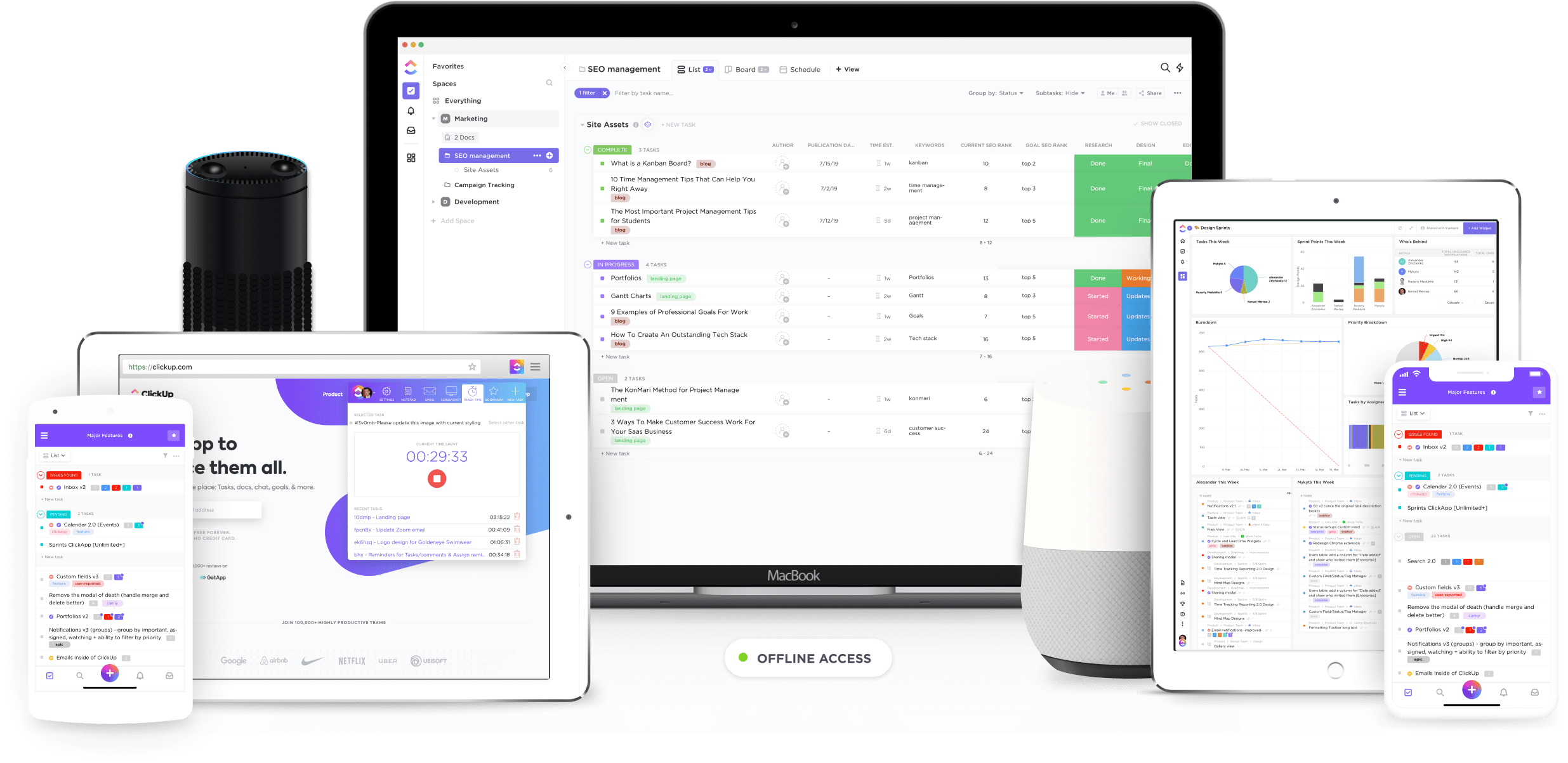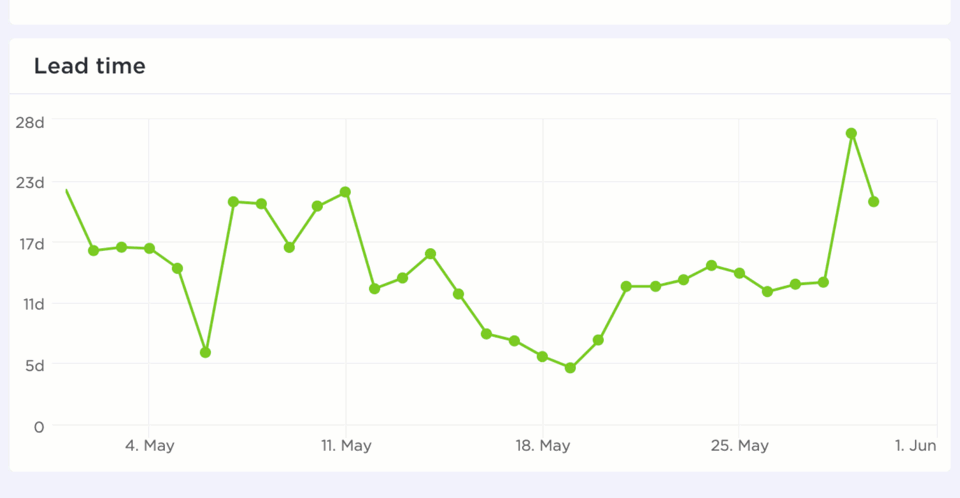تريد أن تتعلم كيفية حساب الوقت المستغرق؟
المهلة الزمنية هي الوقت المستغرق بين تقديم الطلب والتنفيذ، وهي واحدة من أهم المقاييس في إدارة المخزون وتخطيط سلسلة التوريد.
نحن نعلم ما تفكر فيه: _سيكون هذا مثل رياضيات المدرسة الثانوية مرة أخرى!
بالطبع لا!
أنت تحتاج فقط إلى معادلة بسيطة للمهلة الزمنية.
في هذه المقالة، ستتعرف في هذه المقالة على المهلة الزمنية، و معادلة المهلة الزمنية و أسهل طريقة لتتبعه .
_كلاهما يكره الرياضيات ومحبو الرياضيات مرحب بهم للانضمام!
لا مزيد من العد التنازلي. لنبدأ!
ماذا يعني العد التنازلي؟ المهلة الزمنية هو الوقت الذي تستغرقه وحدة عمل واحدة في دورة الإنتاج والتسليم. على سبيل المثال، وقت الطهي والتقديم في المطاعم، أو وقت المعاملات في الأعمال المصرفية، أو
تطوير تطبيقات الهاتف المحمول ووقت الإطلاق في التكنولوجيا
ملاحظة: لكل عمل مهلة زمنية للإطلاق. ومع ذلك، ولأغراض هذا المقال، سنفسر المهلة الزمنية بالإشارة إلى أنا _المخزون _إدارة _وتخطيط سلسلة الإمدادات، _حيث أن هذا هو المكان الأكثر فائدة
لكن لماذا لماذا _يجب أن تكلف نفسك عناء حساب هذا المقياس؟
للإجابة على هذا السؤال، نحتاج إلى التعمق قليلاً في عالم إدارة المخزون أو مراقبة المخزون
على سبيل المثال، لنفترض أنك تدير شركة لتوصيل البقالة.
نظرًا لأنك لا تقوم بتصنيع الحليب أو الجبن أو البيض، فستحتاج إلى الحصول عليها من أحد الموردين. وبمجرد الحصول عليها، ستحتاج إلى تخزينها حتى تبيعها.
المكافأة:_ إدارة علاقات العملاء للتصنيع هذا المخزن للبضائع غير المباعة هو مخزونك.
أثناء إدارته، عليك أن تضع في اعتبارك أمرين:
- تجنب طلب الكثير من المخزون. إذا لم يتم بيع البضائع، فسوف ينتهي بك الأمر بمشاكل في التخزين، وخسارة مالية، وبيض (فاسد) أكثر مما يمكنك أن تتلاعب به!
- دائمًا ما يكون لديك ما يكفي من المخزون لتلبية جميع طلباتك. إذا طلبت القليل جدًا، سيكون لديك قائمة طويلة من الزبائن غير الراضين، _ _ الزبائن الجائعين.

المفتاح؟ حافظدائماًعلىدائماًعلىالمستوىالمناسبللمخزون_
والمهلة الزمنية القصيرة نسبيًا هي إحدى أفضل الطرق لضمان ذلك.
أهمية المهلة الزمنية في إدارة المخزون
إدارة المهل الزمنية أمر بالغ الأهمية للشركات. قد تعني المهل الزمنية التي تتم إدارتها بشكل سيئ أن المخزون قد ينفد ولا يمكن للعملاء تلبية طلباتهم.
عندما تخرج المهل الزمنية عن السيطرة، يمكن أن تتشكل حلقة مفرغة مع تفاقم المهل الزمنية مع زيادة الطلب. قد يؤدي هذا التأخير بين طلبات المستهلكين والإنتاج إلى مزيد من التأخير مما قد يؤدي إلى مزيد من التدهور في المهل الزمنية. وغالبًا ما يتسبب سوء إدارة الطلبات في إلحاق أضرار جسيمة ومكلفة بالشركة حيث تفقد عملاء قيّمين وتضر بسمعتها.
لهذا السبب تتضمن إدارة المخزون التعامل مع العوامل التي تؤثر على المهل الزمنية، مثل:
- الجغرافيا: إذا كان التسليم عبر المدينة أو عبر القارات
- طبيعة السلع: تحتاج السلع القابلة للتلف إلى مهل زمنية أقصر
- الكمية: يحدد معظم الموردين مواعيد التسليم بناءً على الكمية التي طلبتها
- عوامل أخرى: أسعار الشحن، واللوائح، وتوافر المواد الخام، وما إلى ذلك.
وبسبب هذه العوامل، تحدد المهلة الزمنية كمية المخزون و متى يتم إعادة التخزين.
ولكن تمامًا مثلما لا يمكنك إعداد عجة البيض دون كسر البيض، لا يمكنك حساب المهلة الزمنية بدون صيغته.
كيف تحسب المهلة الزمنية؟
المعادلة الأساسية للمهلة الزمنية هي
المهلة الزمنية (LT) = الطلب تاريخ التسليم - تاريخ طلب الطلب
ولكن في سياق إدارة المخزون، تأخذ هذه الصيغة في الحسبان أيضًا تأخير الطلب.
المهلة الزمنية (LT) = تأخير التوريد (SD) + تأخير إعادة الطلب (RD)
تأخير التوريد هو الوقت الذي يستغرقه المورد لتلبية طلب العميل بعد تقديمه.
تأخير إعادة الطلب هو الفجوة الزمنية بين الطلب الذي تم تنفيذه وتقديم الطلب التالي.
_لماذا نأخذ في الحسبان تأخيرالطلب ؟
قد لا يقبل بعض الموردين الطلبات إلا بضع مرات في الأسبوع أو الشهر. وهذا يعني أن تجار التجزئة بحاجة إلى توقع هذا التأخير في التسليم للحفاظ على مخزون أمان أو مخزون احتياطي.
يتيح لك المخزون الاحتياطي تلبية طلباتك بينما تنتظر المورد لتجديد مخزونك.
على سبيل المثال، لنفترض أن متوسط مبيعاتك اليومية أو متوسط الاستخدام اليومي للحليب هو 20 لترًا. والمورد (أ) يقبل طلبات الحليب بعد كل يومين فقط. هذا يعني أن التأخير في إعادة الطلب لمورد الحليب الخاص بك هو يومين.
والآن، لنفترض أن المورد (أ) يستغرق يومًا واحدًا لتوصيل الحليب إلى مستودعك. وهذا يجعل التأخير في التوريد يوم واحد.
في هذه الحالة
المهلة الزمنية = التأخير في التوريد (1 يوم) \ + تأخير إعادة الترتيب (2 يوم) \ = 3 أيام
يجب أن يكون التخزين لمدة 3 أيام سهلًا بما فيه الكفاية.
ولكن ماذا لو كنت تبيع شيئًا عالي القيمة ونادرًا، مثل الأعشاب الغريبة وعناصر الديكور المصممة؟
من المحتمل أن تكون مثل هذه المنتجات بطيئة الحركة نسبياً مقارنةً بالحليب أو البيض ولديها إمدادات عالية وتأخيرات في إعادة الطلب.
هذا يعني أنك ستحتاج إلى التخطيط لشرائها وتخزينها وبيعها شهورًامقدمًا.
ولكن كيف يمكنك معرفة كمية الكمية التي تحتاج إلى تخزينها و متى يجب عليك إعادة التخزين؟
تكمن الإجابة في مخزون الأمان و نقطة إعادة الطلب.
مخزون الأمان: ما هي الكمية التي يجب تخزينها؟
مخزون الأمان هو مستوى المخزون الذي تحتاج إلى الاحتفاظ به لتغطية التأخير في التوريد أو التأخير في إعادة الطلب.
تأخذ معادلته في الحسبان مهلة التسليم وتباين الطلب (التقلبات المحتملة على الطلب).
يمكن أن يتقلب طلب العملاء على المنتجات بسبب عدة أسباب مثل العطلات وعطلات نهاية الأسبوع والتغيرات في أسعار الجملة والعروض وما إلى ذلك.
وبصرف النظر عن ذلك، يحتاج المديرون أيضًا إلى تخزين مستوى من التقلبات غير المتوقعة في الطلب مثل النقص المفاجئ واضطرابات الطقس وما إلى ذلك.
لأنه كما يختلف الطلب، يختلف العرض أيضًا.
معادلة مخزون الأمان هي:
مخزون الأمان = (الحد الأقصى للمبيعات اليومية *الحد الأقصى للمهلة الزمنية) - (متوسط المبيعات اليومية *متوسط المهلة الزمنية)
نقطة إعادة الطلب: متى يتم إعادة التخزين؟
نقطة إعادة الطلب هي مستوى المخزون الذي يتيح لك معرفة أنك بحاجة إلى إعادة الطلب.
بالنسبة لعبارة "تسوق حتى تسقط" -

هذه نصيحة لعملائك فقط
ليس لك!
كمدير للمخزون، يعتمد قرارك بإعادة التخزين على معادلة نقطة إعادة الطلب. وهي
نقطة إعادة الطلب = (المهلة الزمنية * متوسط المبيعات اليومية) + مخزون الأمان
في كل مرة ينخفض مخزونك إلى نقطة إعادة الطلب ، فقد حان الوقت لالتقاط الهاتف و تسوق بعض المخزون!
ستسير كمية إعادة الطلب الخاصة بك جنبًا إلى جنب مع مستوى مخزون الأمان الخاص بك.
اعتبارات أخرى عند حساب المهلة الزمنية
المهلة الزمنية ARO
بعد استلام الطلب (ARO) هي النقطة التي يستلم فيها المورد الطلب. هذه هي النقطة الأولى المهمة عند قياس المهلة الزمنية، حيث أن إجمالي الوقت بين ARO وتسليم الطلب يشكل المهلة الزمنية.
مهلة التصنيع #### مهلة التصنيع
مهلة التصنيع هي الوقت الفاصل بين الوقت الذي يضع فيه التاجر طلب الشراء وقيام الشركة المصنعة للمنتج بإكماله. ويشمل الوقت اللازم للحصول على البضائع أو تصنيعها أو شحنها.
والآن بعد أن أصبحت الآن مسلحًا بكل هذه الصيغ، دعنا ندخل في كيفية تقليل مهلة التصنيع.
كيف تقلل المهلة الزمنية؟
سلسلة التوريد مثل الشريط المطاطي. كلما قمت بتمديدها لفترة أطول، كلما أصبحت أضعف.
وفي نهاية المطاف، يمكن أن تنفجر!
ومن ناحية أخرى، فإن سلسلة التوريد القصيرة نسبياً تفيد الجميع.
يمكن لتاجر التجزئة بيع المزيد من السلع بسرعة. ويمكن أن يطمئن المورد إلى استمرار العمل.
والأهم من ذلك، يحصل المستهلك النهائي على ما يحتاج إليه، عندما يحتاج إليه.
_إذن كيف يمكنك تقليل الوقت المستغرق لبناء سلسلة توريد مربحة للجانبين؟
إليك بعض الأفكار:
1. تنظيم كمية الطلبات
لن تخمن أبدًا ما هو المشترك بين إدارة المخزون والنظام الغذائي الصحي.
_التحكم في كمية الطلبات!
هذا صحيح.
بدلاً من تقديم طلب من حين لآخر بكميات كبيرة، قم بتقديم طلبات صغيرة بشكل متكرر أكثر.
سيصبح هذا أسهل إذا قمت بحساب مستويات المخزون الآمن بانتظام وتحديث مستوى إعادة الطلب وفقًا لذلك.
ووفقًا لمبادئ التصنيع الليّن، فإن الطلبات الصغيرة التي يتم تقديمها بشكل متكرر لها ثلاث فوائد:
- الطلبيات الصغيرة أسهل في التصنيع والشحن، وبالتالي تقلل من مهلة التسليم
- نظرًا لأنها تتطلب مراقبة دقيقة لمستوى المخزون لديك، يمكنك تجنب الإفراط في التخزين
- بدون مخزون زائد، يمكنك التوفير في تكلفة حمل المخزون (إيجار المخزن، والموظفين، وما إلى ذلك)
وتمامًا مثل بعض الوجبات الصغيرة الموزعة على مدار اليوم، فإن الطلبات الصغيرة والمتكررة تحافظ على تجديد مخزونك لفترة أطول!
2. إجراء تمارين تخطيط تدفق القيمة
عندما يتعلق الأمر بإدارة المخزون، فإن عملية التصنيع اللين هي الهدية التي تستمر في العطاء.
تدفق القيمة هو عملية (ذات خطوات متعددة مترابطة) تحتاج المنظمة إلى اتخاذها لتنفيذ الحلول.
A تمرين تخطيط مسار القيمة يهدف إلى التعرف على الهدر وتحسين الإنتاجية وجعل تدفق القيمة أكثر كفاءة وخالية من الهدر.
مكافأة: تحقق من أعلى
href/ https://clickup.com/blog/value-stream-mapping-templates// 10 قوالب تخطيط تدفق القيمة لتحسين عمليات الفريق* %/%href/_
3. أتمتة عملية مراقبة المخزون
سلّم المهام المتكررة للتكنولوجيا وخذ تلك الاستراحة التي تستحقها.
يمكن للروبوتات إدارة حساب مخزون الأمان، ومتوسط الطلب، وتغير الطلب.
في هذه الأثناء، تحدث إلى الموردين، وراقب اتجاهات السوق، أو ضع الخطة التسويقية الكبيرة التالية!
4. تحسين سلاسل التوريد المحلية
تذكر كيف أن سلسلة التوريد_ مثل الشريط المطاطي؟
حسنًا، عدد قليل جدًا من الأربطة المطاطية مرنة بما يكفي للالتفاف حول العالم!
قد يغريك الموردون الدوليون والعابرون للبلدان بالخصومات. لكن المهلة الطويلة (وما يصاحبها من متاعب) لا تستحق دائماً الأسعار المنخفضة.
الموردون المحليون في وضع أفضل لفهم احتياجاتك الفريدة والاستجابة لها بشكل أسرع. وإذا كانوا يقدمون أيضًا أسعارًا تنافسية لمنتجات رائعة، فهم يستحقون الاحتفاظ بهم.
5. إدارة العلاقات مع الموردين
في نهاية المطاف، مراقبة المخزون هي شأن بشري.
لذا فإن علاقتك مع المورد ستكون عاملاً حاسمًا في تحديد مدة المهلة الزمنية التي ستستغرقها.
في عقدك معهم، استخدم الحوافز لتقليل المهلة الزمنية.
يمكن أن تكون
- الحوافز الإيجابية: حصة في الأرباح، وحالة الأولوية، وامتيازات مختلفة
- الحوافز السلبية: العقوبات، وفقدان الأعمال، والمراجعة من قبل المديرين
في نهاية المطاف، سيشجع ذلك الموردين على تقليل الوقت المستغرق في كل عملية تسليم لأنهم يشعرون بأنهم يستثمرون في عملك.
ولكن لتحقيق كل هذا، عليك أن تبدأ بـ حساب مهلة التسليم.
لكن انسَ أمر القلم والورقة.
لدينا الحل الأمثل لك!
الطريقة الأسهل لإدارة الوقت المستغرق: ClickUp
بين تفريغ المخزون وتنزيل الملفات، بالكاد يكون لديك الوقت الكافي كمدير للمخزون. لذا فإن حساب المهلة الزمنية بالطريقة القديمة الجيدة أمر غير وارد.
لهذا السبب نقترح استخدام ClickUp.
ما هو ClickUp؟
 ClickUp
هو
أداة إدارة المشاريع الأعلى تقييمًا
في العالم.
ClickUp
هو
أداة إدارة المشاريع الأعلى تقييمًا
في العالم.
إنها الأداة الوحيدة التي ستحتاج إليها لإدارة جميع مشاريعك وتتبع إنتاجية فريقك.
مجموعة ديناميكية من رشيقة , سكروم , العمل عن بُعد ميزات مثالية لفريقك الاستثنائي.
ألقِ نظرة على كيفية استخدام ClickUp لـ حساب الوقت المستغرق في العمل واستخدام المقياس لـ تعزيز أداء فريقك.
أ. تتبع المهلة الزمنية باستخدام أدوات سبرينت على
لوحة التحكم يمكنك أن تفحص مقاييس مشروعك، واحدًا تلو الآخر، مع عشرات الشرائح والمطبوعات في PowerPoint. Yawn.
أو يمكنك تتبعها جميعًا مرة واحدة، على لوحة معلومات ClickUp !

ستتحدث لوحة التحكم الخاصة بك عن نفسها بمساعدة أدوات Sprint Widgets العملية مثل الرسم البياني لوقت التشغيل.
قم بتخصيص الرسوم البيانية لوقت التنفيذ باستخدام:
- النطاق الزمني: اختر نطاقًا زمنيًا وحدد وتيرة الرسم البياني لوقت المهلة
- عينة الوقت: حدد عدد الأيام التي تريد تضمينها كمتوسط لكل نقطة على الرسم البياني
- مجموعة الحالة المحسوبة كإكمال: اختر بين مجموعة الحالة "مغلق" أو أي مجموعة حالة "تم" لاحتسابها ضمن الإكمال

ولكن هناك المزيد!
يمكنك الحصول على نظرة عامة كاملة عن طريق إضافة المزيد من أدوات سبرينت المفيدة مثل المخططات البيانية , مخططات الاحتراق , مخططات السرعة و مخططات التدفق التراكمي إلى لوحة التحكم الخاصة بك.
ب. وقت تقدمك مع تقديرات الوقت يتيح لك ClickUp حساب مقاييس تدفق المشروع المهمة مثل
المهلة الزمنية ووقت الدورة. مع وجود هذه البيانات المهمة في متناول اليد، يمكنك التنبؤ بجميع الجداول الزمنية المستقبلية وتعيين تقديرات الوقت.
ما عليك سوى إضافة عدد الساعات لكل المهمة و مهمة فرعية يتيح لك تتبع الوقت بسهولة سواء كنت تستخدم سطح المكتب أو الويب أو تطبيق الهاتف المحمول. يمكنك أيضًا إضافة ملاحظات وتسميات إلى سجلات وقتك للحصول على مرجع إضافي، أو وضع علامة على الوقت كوقت قابل للفوترة!

يفضل استخدام متعقب وقت تابع لجهة خارجية مثل تايم دكتور أو توجل بدلاً من ذلك؟
لا تقلق. فقط دمجها مع ClickUp وابدأ العمل!
لكن هذه مجرد قائمة صغيرة _من الطرق التي يسهل بها ClickUp عملياتك
استفد من ميزات إدارة المشاريع المتميزة الأخرى مثل: حد WIP و زمن الدورة مقابل المهلة الزمنية .
الخلاصة
للوهلة الأولى، يخبرك مقياس المهلة الزمنية ببساطة عن المدة التي سيستغرقها التسليم. ولكن إذا نظرت عن كثب، ستجد أنه يمكن أن يشير إلى التأخيرات غير الضرورية والهدر والعوامل الأخرى التي تعيق سلسلة التوريد الخاصة بك.
هذا هو السبب في أن حساب المهلة الزمنية هو أسهل طريقة لضمان أن تظل سلسلة التوريد الخاصة بك فعالة وكفؤة.
ولكن كيف يمكنك التحكم في المهلة الزمنية للمهلة الزمنية حساب المهلة الزمنية_؟
ببساطة. باستخدام أداة عبر الإنترنت تقوم بحساب وتتبع المهلة الزمنية.
بعبارة أخرى: انقر فوق!
لا تحتاج أداة المهلة الزمنية سهلة الاستخدام سوى بعض الإعدادات السريعة لبدء جمع البيانات على الفور. وهي ليست سوى واحدة من مئات الميزات الفريدة والمثيرة للإعجاب التي تجعل إدارة المشروع في غاية السهولة.
لذلك احصل على ClickUp مجانًا لتقليل الوقت الذي تستغرقه في التسليم وزيادة..


